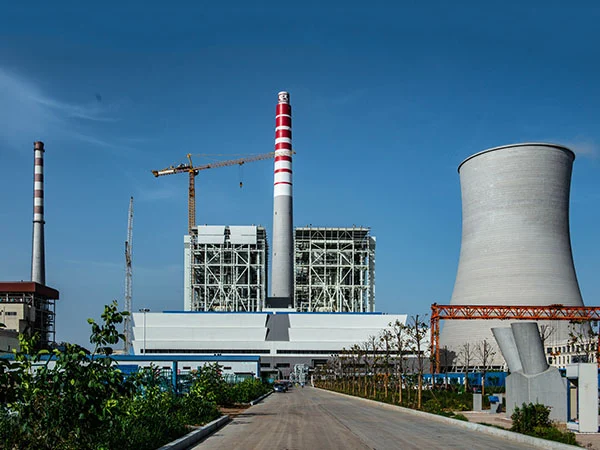Building Use:Power plant coal handling system
Area:320m²
Steel Usage:300t
Factory Structure and Project Features:Large span trestle bridge, maximum span 54 meters
Project Challenges & Overcoming Process: The 54-meter span was hoisted in one piece, using a 400-ton crawler crane.

Steel structures are the foundational framework for power plants, providing the skeleton and support for the entire facility and its heavy machinery. They are used extensively across various types of power plants, including those that use fossil fuels, nuclear energy, or renewable sources like wind and solar.
Steel is chosen over other materials like reinforced concrete for several critical reasons:
High Strength-to-Weight Ratio: Steel provides immense strength with relatively low weight. This allows for long, open spans (essential for turbine halls), smaller foundations, and the ability to support extremely heavy equipment like boilers, turbines, and generators.
Speed of Construction: Steel components are prefabricated off-site in controlled factory conditions. This allows for parallel construction activities (foundation work on-site while the structure is being made) and leads to faster, more predictable on-site erection, reducing project timelines.
Design Flexibility and Large Spans: Steel allows architects and engineers to design vast, column-free spaces. This is crucial for the Turbine Hall and Boiler House, which need to accommodate massive equipment and provide clearance for overhead cranes used for installation and maintenance.
Durability and Resilience: Steel structures, when properly designed and protected, can withstand significant environmental stresses, including high winds, seismic activity, and operational vibrations from heavy machinery.
Modifications and Adaptability: Power plants often require upgrades or equipment changes over their lifespan. Steel structures are easier to modify, reinforce, or expand compared to concrete structures.
Sustainability: Steel is one of the most recycled materials in the world. At the end of a plant's life, the steel structure can be dismantled and fully recycled.
A power plant is not a single building but a complex of interconnected structures. Steel is used in virtually all of them.
1. The Main Power Block
This is the heart of the power plant.
Boiler House / Steam Generator Building: This is often the tallest structure on site, housing a massive boiler suspended from a complex steel support grid at the top.
The structure must handle immense weight and thermal expansion.
Turbine Hall: A long, wide-span building housing the turbine-generator set. The main steel frame supports the building envelope and, most importantly, heavy-duty overhead gantry cranes (often 100+ tons capacity) used for lifting and maintaining the turbine components.
Deaerator Bay: A multi-level steel structure supporting the deaerator and other feedwater heating equipment, often located between the boiler and turbine areas.
2. Material Handling and Storage
Conveyor Systems: Long-span steel trusses support conveyor belts that transport fuel (like coal, biomass, or petcoke) from storage areas to the boiler.
Bunkers and Silos: Steel-plate structures, supported by a heavy steel frame, used to store fuel before it's fed into the boiler.
Stacker-Reclaimers: Massive, moving steel machines used in the coal yard.
3. Support Infrastructure
Pipe Racks: The "arteries" of the plant. These are extensive, multi-level steel frames that support thousands of pipes carrying steam, water, fuel, and chemicals, as well as electrical cable trays. They must be designed to handle weight, thermal expansion, and wind loads.
Cooling Towers: While many large cooling towers use a concrete hyperbolic shell, the internal components (the "fill" and water distribution system) are often supported by a steel or stainless steel structure. Air-cooled condensers (ACCs) are massive steel structures that look like buildings on stilts.
Switchyard Structures: Galvanized steel gantries and towers that support high-voltage busbars, insulators, and circuit breakers to direct the generated electricity to the transmission grid.
4. Environmental and Ancillary Systems
Flue Gas Desulfurization (FGD) Units / Scrubbers: Large, complex steel structures and ductwork used to clean emissions before they are released.
Precipitators and Baghouses: Steel-framed structures that remove particulate matter (fly ash) from flue gas.
Chimney/Stack: While the outer shell can be concrete, the internal flues are often steel liners supported by a steel lattice framework within the main structure.
Designing steel structures for a power plant is highly specialized and goes beyond standard building design.
Heavy Loads: The structures must support immense dead loads (equipment weight), live loads (maintenance activities), vibrational loads from rotating machinery, and thermal loads from high-temperature pipes and equipment.
Seismic and Wind Design: Power plants are critical infrastructure, so they are designed to withstand the most severe earthquakes and wind events expected in their location.
Corrosion Protection: The industrial and often coastal environment of a power plant is highly corrosive. Steel is protected through:
Hot-dip galvanizing: For lighter structures like handrails, grating, and switchyard components.
High-performance industrial coatings: Multi-layer paint systems applied to the main structural steel.
Fire Protection: While a power plant is largely non-combustible, fire protection is critical for certain areas to prevent structural collapse during a fire, allowing for safe shutdown and evacuation. This is often achieved with intumescent coatings or concrete encasement.
Connection Design: Connections (bolted or welded) are critical. They must be designed to handle complex forces, including fatigue from vibrations.
Modular Construction: Increasingly, entire sections of a power plant, like large pipe rack modules or equipment skids, are fully assembled, tested, and pre-dressed off-site. These modules are then transported and lifted into place, drastically reducing on-site construction time and improving safety.
Advanced Materials: Use of high-strength, low-alloy (HSLA) steels and corrosion-resistant steels to reduce weight and improve the lifespan of the structure.
Digitalization (BIM): Building Information Modeling (BIM) is now standard. A detailed 3D digital model of the entire plant (including steel, concrete, equipment, and piping) is created. This allows for clash detection, optimized construction sequencing, and serves as a "digital twin" for asset management throughout the plant's life.
Renewable Energy Plants: Steel is the primary material for wind turbine towers, the mounting structures for large-scale solar farms, and the structural framework for geothermal and biomass power plants.

Create the greatest value for customers
Provide the best quality products and services
+8618800767079
info@hcggsteel.com
No.1 Shuangxiang Road, Luoxin Industrial Park, Luoyang City